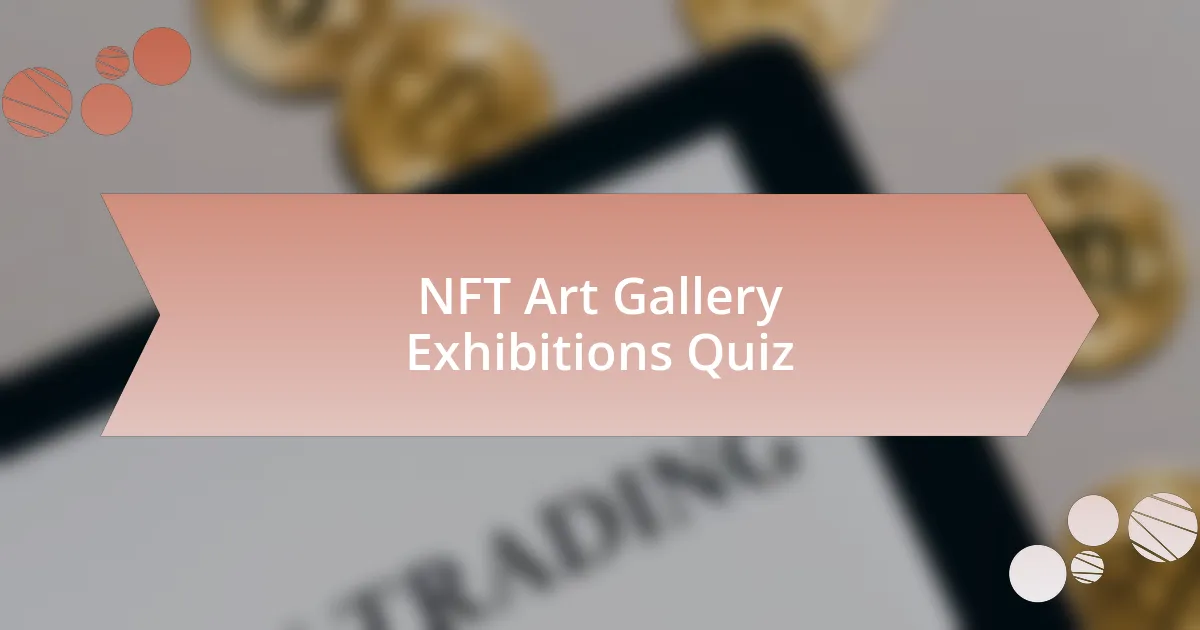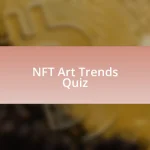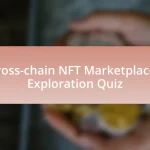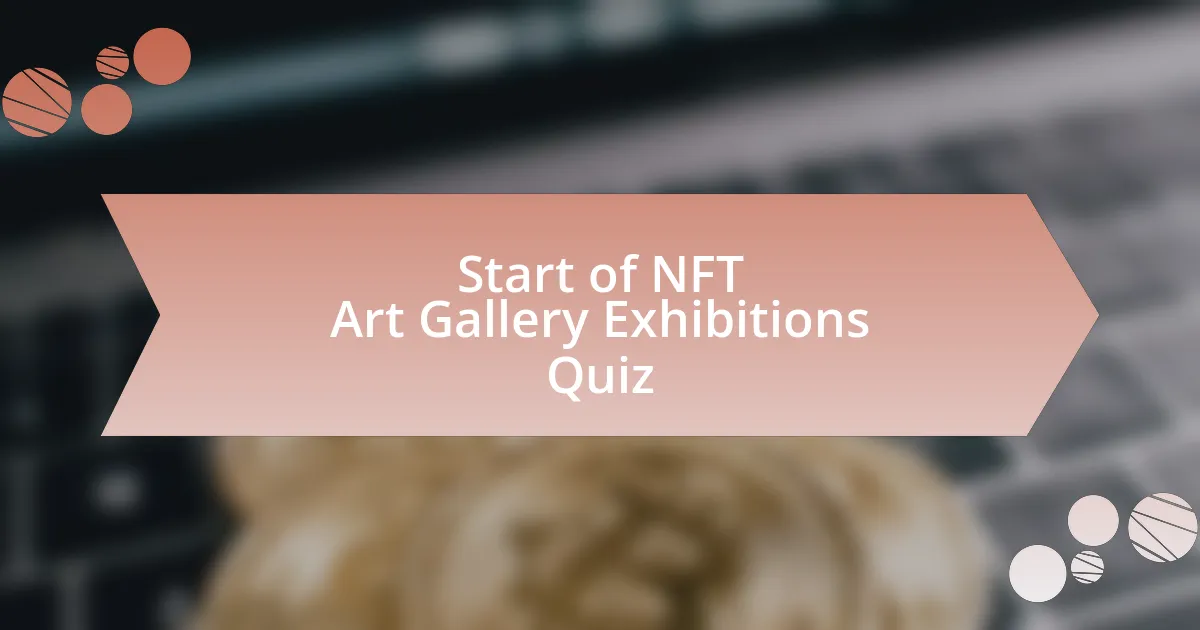
Start of NFT Art Gallery Exhibitions Quiz
1. What does NFT stand for in the context of digital art?
- Networked financial token
- Non-volatile transaction
- Non-fungible token
- Notable fictional trend
2. Why are NFTs considered unique compared to traditional digital files?
- NFTs are stored on blockchain making them unique.
- NFTs can be easily copied like regular files.
- NFTs are only unique because of their appearances.
- NFTs are similar to physical items, like paintings.
3. How does blockchain technology contribute to the value of NFTs?
- Blockchain allows NFTs to be easily replicated and counterfeited.
- Blockchain technology ensures the uniqueness and ownership of NFTs.
- Blockchain is not used in the ecosystem of NFTs at all.
- Blockchain prevents the sale of NFTs altogether.
4. Where is the Moco Museum`s NFT exhibition located?
- Berlin
- London
- Barcelona
- Amsterdam
5. Who is a well-known digital artist that has been featured in NFT exhibitions?
- Van Gogh
- Monet
- Beeple
- Picasso
6. What distinguishes an NFT gallery from a traditional art gallery?
- An NFT gallery offers art supplies for creators.
- An NFT gallery showcases digital art through blockchain.
- An NFT gallery sells only physical paintings.
- An NFT gallery is the same as a traditional gallery.
7. Can NFTs represent more than just art, such as music or virtual real estate?
- Yes, NFTs can represent music and virtual real estate.
- No, NFTs only represent physical collectibles.
- No, NFTs can’t represent any form of media.
- Yes, NFTs are limited to digital paintings.
8. What role does decentralization play in the creation of NFTs?
- Decentralization reduces the uniqueness of digital assets in NFT creation.
- Decentralization centralizes the control of NFT platforms and restricts access.
- Decentralization eliminates the need for blockchain technology in NFTs.
- Decentralization allows for greater ownership control and transparency in NFT transactions.
9. How do collectors confirm the authenticity of an NFT?
- By obtaining a signed certificate from the artist
- By reviewing the gallery`s reputation
- By checking the blockchain trace of ownership
- By asking for a copy of the artwork
10. What is a significant challenge associated with NFT ownership?
- The lack of clear regulations.
- The difficulty of programming smart contracts.
- The inability to store digital assets.
- The abundance of free digital art online.
11. In what way can museums leverage NFTs for educational purposes?
- Museums can create interactive NFT exhibits for educational purposes.
- Museums can only sell NFTs for profit.
- Museums can ignore digital rights for NFTs.
- Museums can use NFTs solely for fundraising.
12. How do NFT marketplaces facilitate the buying and selling of digital art?
- NFT marketplaces charge buyers only for viewing digital art for free.
- NFT marketplaces require physical artwork to conduct sales and purchases.
- NFT marketplaces allow anyone to create and issue NFTs without any validation.
- NFT marketplaces use blockchain to verify ownership and facilitate transactions.
13. What is the purpose of a virtual reality NFT gallery?
- To generate profit through ticket sales only.
- To host live music concerts exclusively.
- To display and sell digital art in an immersive environment.
- To create physical art pieces for buyers.
14. How do NFT exhibitions impact the traditional art market?
- NFTs are not recognized in the traditional art community whatsoever.
- NFTs have transformed the art market by providing new platforms for artists to sell their work.
- NFTs only benefit established artists without affecting newcomers.
- NFTs have no impact on the traditional art market at all.
15. What characteristics define an effective NFT gallery curation?
- Clarity of vision and purpose in selection.
- Variety of colors and textures in art.
- Use of traditional painting techniques only.
- Size of displayed artworks matters most.
16. How can artists benefit from minting their art as NFTs?
- Artists lose control over their artwork when minting as NFTs.
- Artists can only create physical copies of their art.
- Artists can gain exposure and royalties from their work.
- Artists have to pay fees to display their work online.
17. What are some notable NFT art sales that have made headlines?
- Banksy`s `Girl with Balloon` sold for $10 million.
- Picasso`s `Guernica` sold for $50 million.
- Beeple`s `Everydays: The First 5000 Days` sold for $69 million.
- Van Gogh`s `Starry Night` sold for $30 million.
18. How are NFTs changing the way artists interact with their audience?
- NFTs enable artists to sell their work directly to collectors and engage through unique experiences.
- NFTs restrict artists from connecting with their audience effectively.
- NFTs prevent artists from retaining ownership of their artwork.
- NFTs limit artist exposure to traditional galleries only.
19. What potential risks do buyers face when purchasing NFTs?
- Fixed retail prices set by manufacturers
- Unlimited supply without restrictions
- Market volatility and potential for loss
- Guaranteed profit margins and stable income
20. How important is community engagement for the success of an NFT project?
- Extremely important for success.
- Somewhat important but not necessary.
- Not important at all for success.
- Only important for funding issues.
21. What factors should you consider when choosing an NFT platform?
- Number of NFTs available
- Popularity of the artist
- Average price of NFTs
- Trustworthiness of the platform
22. How has the perception of digital art evolved with the rise of NFTs?
- Digital art has remained unchanged and unrecognized over time.
- The rise of NFTs has decreased interest in traditional art forms entirely.
- Digital art was already widely accepted before NFTs became popular.
- NFTs have elevated digital art recognition and legitimacy, making it a viable market.
23. In what ways can NFTs support charitable causes?
- NFTs eliminate the need for charitable organizations.
- NFTs can only be created for personal use.
- NFTs can raise funds for charities through auctions.
- NFTs provide tax deductions to all buyers.
24. How do NFT events help in building networks for artists and collectors?
- NFT events focus solely on selling artwork.
- NFT events are exclusively for game developers.
- NFT events facilitate connections between artists and collectors.
- NFT events limit collaboration between artists.
25. What is the significance of `provenance` when discussing NFTs?
- It establishes authenticity and ownership history of the NFT.
- It is related to the number of copies of the NFT.
- It determines the physical location of the NFT.
- It dictates the sale price of the NFT.
26. How does the Seattle NFT Museum enhance the local arts community?
- The Seattle NFT Museum enhances the local arts community through fashion shows and merchandise sales.
- The Seattle NFT Museum enhances the local arts community by selling NFTs exclusively.
- The Seattle NFT Museum enhances the local arts community through exhibitions and educational workshops.
- The Seattle NFT Museum enhances the local arts community by hosting private events only.
27. What technological advancements have enabled the growth of NFTs?
- Blockchain technology
- 3D printing
- Satellite technology
- Social media
28. What strategies do NFT galleries use to attract visitors?
- Focusing solely on one genre of digital art
- Utilizing interactive exhibitions to engage audiences
- Offering only traditional art pieces to attract collectors
- Charging high fees for entry to limit visitors
29. How does the concept of ownership differ in the digital versus physical art world?
- Ownership of digital art is determined by the artist`s reputation.
- Ownership in the digital art world is defined by unique tokens on the blockchain.
- Ownership in digital art means having a printed copy of the artwork.
- Ownership in digital art is established by physical possession of the artwork.
30. What role do tokens play in the functionality of NFTs?
- Tokens function solely as promotional tools for NFT creators.
- Tokens act as a currency for purchasing physical assets only.
- Tokens are used to restrict access to NFT art galleries and exhibitions.
- Tokens represent unique digital ownership and enable transactions for NFTs.

Quiz Successfully Completed!
Congratulations on completing the quiz on NFT Art Gallery Exhibitions! We hope you found the experience enjoyable and enlightening. Engaging with questions about this innovative art form has likely deepened your understanding of how NFTs are revolutionizing the art world. You might have learned about the unique characteristics of NFT artworks, as well as how galleries are adapting to showcase these digital pieces.
We encourage you to reflect on the various aspects of NFT exhibitions that were covered. From the emergence of digital art to the debate around ownership and value, there are many layers to this topic. Each question may have sparked curiosity or challenged your views on modern art. The insights gained can inspire further exploration and appreciation of NFT culture.
For those eager to learn more, we invite you to check the next section on this page. It offers a deeper dive into NFT Art Gallery Exhibitions, including case studies, key players, and the future of this exciting field. Expanding your knowledge will enhance your understanding and keep you informed about the ongoing changes in the art landscape!
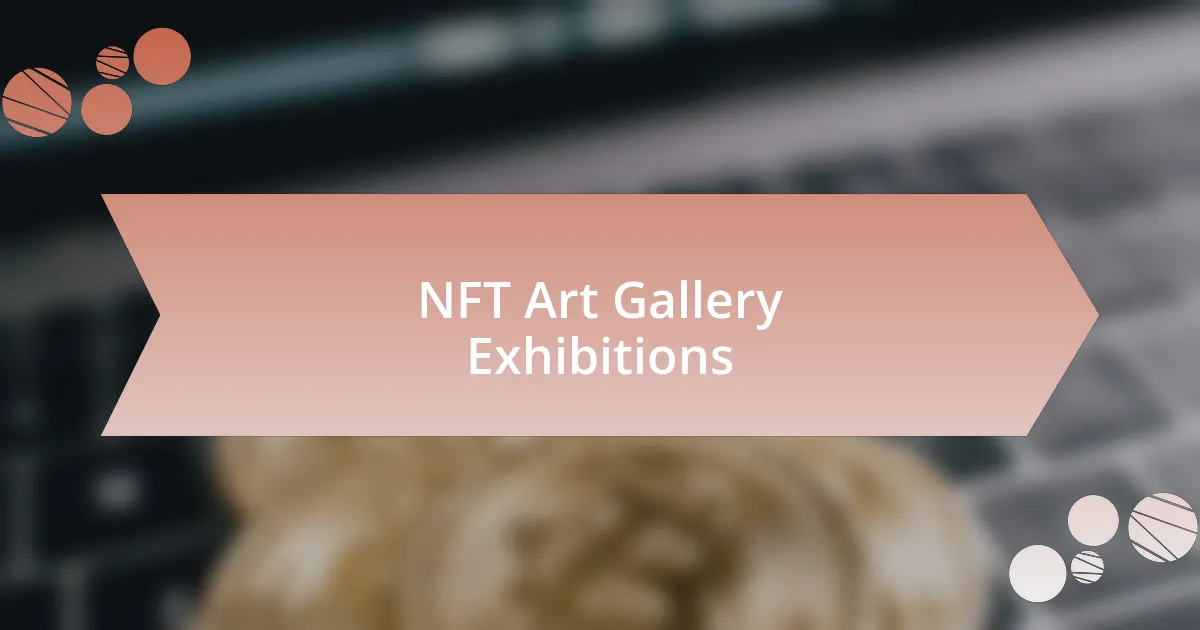
NFT Art Gallery Exhibitions
Understanding NFT Art Gallery Exhibitions
NFT art gallery exhibitions showcase digital artworks verified by blockchain technology. These platforms allow artists to display and sell their non-fungible tokens (NFTs) directly to collectors. The rise of cryptocurrencies has transformed traditional art exhibitions into digital spaces. Galleries may be physical or virtual, allowing access to a global audience. Key examples include museums launching NFT sections to engage new art communities and broaden their reach.
The Role of Blockchain in NFT Art Galleries
Blockchain technology underpins the authenticity and provenance of NFTs in art galleries. Each NFT is created using a blockchain, typically Ethereum. This technology ensures that digital artworks can be traced back to their original creator. Galleries utilize blockchain to provide transparency and trust between artists and collectors. The immutable nature of blockchain prevents art forgery and establishes ownership rights.
Curating NFT Art Exhibitions
Curating NFT art exhibitions involves selecting artworks that highlight trends and innovation in digital art. Curators assess artistic merit, uniqueness, and the artist’s background while picking NFTs for display. The curation process enhances the collections by emphasizing diverse artistic expressions. Art exhibitions often blend various mediums, including animations, digital paintings, and generative art. Effective curation captures audience interest while educating visitors about NFT art.
Challenges Facing NFT Art Gallery Exhibitions
NFT art gallery exhibitions confront several challenges, including environmental concerns and market volatility. The energy consumption of blockchain networks raises sustainability issues. Additionally, the fluctuating value of cryptocurrencies can affect the perceived worth of NFTs. Galleries must also navigate the evolving legal landscape surrounding digital ownership. These difficulties complicate the organization and promotion of exhibitions in the NFT space.
Future Trends in NFT Art Gallery Exhibitions
The future of NFT art gallery exhibitions includes increased integration of augmented reality (AR) and virtual reality (VR). These technologies aim to enhance the viewer experience by offering immersive interactions with art. The rise of decentralized platforms may allow artists to exhibit without traditional gatekeepers. Moreover, collaborations between artists and tech companies could lead to innovative formats for showcasing NFTs. Such trends promise to revolutionize the way digital art is experienced and sold.
What are NFT Art Gallery Exhibitions?
NFT Art Gallery Exhibitions are curated events showcasing digital artworks in the form of non-fungible tokens (NFTs). These exhibitions can take place in virtual galleries, physical spaces, or both. They provide a platform for artists to display and sell their creations while allowing collectors and enthusiasts to experience digital art in an immersive environment. Many NFT exhibitions have gained attention through well-known platforms like SuperRare and Foundation, illustrating the growing acceptance of digital art in the mainstream art market.
How do NFT Art Gallery Exhibitions work?
NFT Art Gallery Exhibitions work by displaying digital artworks that are minted as NFTs on blockchain technology. Artists typically submit their works to a gallery or platform, which then organizes the exhibition. Visitors can view, interact with, and often purchase the artworks directly through the platform. The blockchain ensures authenticity and ownership, providing provenance for each piece. As of 2023, sales from NFT art exhibitions have reached significant figures, indicating their impact on art commerce.
Where can you find NFT Art Gallery Exhibitions?
You can find NFT Art Gallery Exhibitions on various online platforms, such as OpenSea, Rarible, or specific NFT marketplaces like Nifty Gateway. Additionally, some physical art galleries have begun hosting hybrid exhibitions, merging traditional physical displays with digital NFTs. Events and fairs dedicated to NFTs, like TEFAF and Art Basel, also incorporate NFT exhibitions, expanding their reach in the art world.
When did NFT Art Gallery Exhibitions begin to gain popularity?
NFT Art Gallery Exhibitions began to gain popularity around 2020, coinciding with a boom in interest for digital art and blockchain technology. The sale of Beeple’s NFT artwork for $69 million at Christie’s in March 2021 marked a turning point, leading to increased visibility and acceptance of NFT exhibitions. This milestone catalyzed numerous other exhibitions, highlighting a shift in the art landscape toward digital formats.
Who participates in NFT Art Gallery Exhibitions?
Artists, collectors, curators, and art enthusiasts participate in NFT Art Gallery Exhibitions. Artists create and submit their digital artworks as NFTs. Collectors are individuals or organizations interested in purchasing these digital assets. Curators organize and thematically develop the exhibitions, selecting works based on various criteria. Major exhibitions have featured both established and emerging artists, reflecting a diverse range of styles and concepts within the NFT space.

